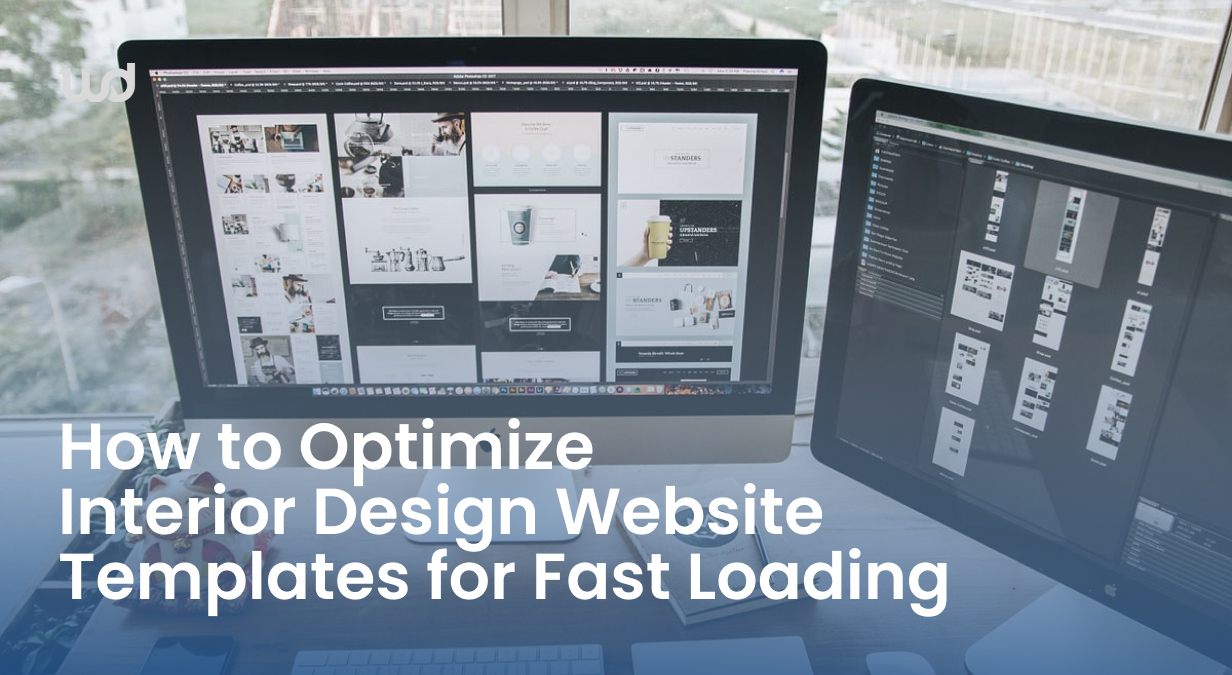How to Optimize Interior Design Website Templates for Fast Loading

The significance of the site’s speed cannot be overstated. Therefore, interior design website templates have marked crucial importance in the real estate industry due to their digital presence and good performance in depicting their web design outlooks to customers.
Optimizing the interior design website for fast loading is a multi-faceted process that addresses numerous variables responsible for causing slow performance. Right from high-definition images that emphasize finer details of the designs to interactive features that engage with visitors, each aspect must be optimized to facilitate fast and glitch-free loading.
To interior design companies, this translates into missed inquiries, fewer consultations, and ultimately fewer earnings. Google also takes page speed into its algorithm, which means slower website designs usually grapple with ranking issues on search engines, again impacting visibility and organic traffic.
Furthermore, people nowadays expect instant results, and a slow website can drive away potential clients in an instant. According to industry reports, even a one-second delay in page load time can cause conversions to fall by 7%.
This definitive handbook delves into tested strategies, combined with actual-case scenarios and in-practice suggestions, to optimize interior design companies’ site speed. Through these optimizations, businesses can eventually gain growth and success in the competitive interior design website market.
The Impact of Slow Load Times
Sluggish websites can actually affect user experience and business results. Even a second delay can negatively impact the lead and conversion rates. One report by Google shows that around a 20% decline can be seen due to slack-off website loadings. Moreover, 53% of mobile site users will prefer dropping the use of the website if the loading times lead to more then three to five seconds. Hence, you can buy interior design website templates to resolve this problem to a minimum extent.
Key Factors Influencing Website Loading Times
A number of reasons are responsible for delayed loading times on interior design websites:
- Large Image Files
High-quality images are necessary to display design portfolios but can drag loading times down considerably if not optimized.
- Heavy Multimedia Content
Animations and videos, while great at engaging the user, can contribute to the load time if they are not properly managed. To check the most engaging and captivating content, you can check our website.
- Inefficient Code
Large HTML, CSS, and JavaScript files can make a website slow.
- Server Speed
Slow response from the server can clog the loading pipeline.
- No Caching
The absence of correct caching mechanisms requires websites to constantly reload resources, thereby slowing the load time.
Optimization Techniques for Load Time
Image Optimization
Images are crucial for displaying interior design portfolios, yet they can tremendously affect load time if not properly optimized. Image file sizes must be restricted while keeping the quality intact.
Steps:

Compressing images using utilities such as TinyPNG or ImageOptim is recommended. These compress images by eliminating unnecessary metadata and lowering file sizes.

Select a proper format for your images. Such as WebP is more compressed than JPEG or PNG and is supported by all recent browsers.

Use responsive images by employing the secret attribute in HTML. This enables browsers to download the correct-sized image depending on the screen resolution of the device.

Delays loading offscreen images until users scroll close to them. This shortens the initial load time and enhances overall performance. Also, make sure you download interior design website templates to check the loading speeds.
Case Study: Luxe Interiors
A case in point for Luxe Interiors is considerable in this scenario, which encountered inauspicious loading times because of high-end images that were huge in load. Therefore, it employed the Best website design for real estate agents who were familiar with the compressing technique, and used the WebP system; they minimized the image sizes by nearly 50%. This result contributed to a decline of 40% in overall load time and a 25% increase in user engagement.
Minimize HTTP Requests
Every feature on the interior design website has to have an individual mechanism for HTTP requests, and these can legit ascend and work on the load times. Further, reducing the number of requests can have a drastic effect on performance.
Steps

Merge several CSS and JavaScript files into one file to minimize the number of requests.

Employ CSS sprites to merge several images into one, minimizing the number of image requests.

Inline small CSS or JavaScript files into the HTML to avoid making them separate requests.

Remove unused plugins from your site regularly to minimize unnecessary requests.
Enable Browser Caching
Browser caching stores static files on a user’s device and relieves and curbs the stress of the need to reload them on subsequent visits. Moreover, this is instrumental for returning visitors only. This is particularly beneficial for returning visitors. But customizations are always available in this regard. You can get customizable interior design templates from custom construction web page design firms to get your desired samples.

Steps

Marking expiration dates incorporating the Cache-Control header for static content such as images, CSS, and JavaScript.

Employ a content delivery network (CDN) to cache content in proximity to the users, eliminating latency and shortening load times.

Employ version control for the cached files to provide users with the latest version when there is a change made.
Optimize Code
Poor code can make a website slower, and premium interior design website themes should be incorporated into the websites for potential customers. Moreover, minifying CSS, JavaScript, and HTML files eliminates extraneous characters and whitespace, shrinking file sizes.
Steps

Utilize tools such as UglifyJS for JavaScript, CSSNano for CSS, and HTMLMinifier for HTML to minify code.

Periodically scan your codebase for unused code and eliminate it to decrease file sizes.

Load JavaScript files asynchronously to avoid blocking the page from rendering.
Case Study: Urban Designs
Urban Designs had inefficient code, resulting in slow loads. Minifying their CSS, JavaScript, and HTML files helped minimize file size by 30%. This meant loading was improved by 20%, and the entire performance improved.
Optimise Server Response Times
Unresponsive server loading times can delay the process to a standstill. Improving server response speeds is imperative when it comes to quick load times.
Steps

Choose the hosting service provider with ample resources and stable uptime.

Implement server-side caching to minimize the server load and response times.

Periodically monitor server performance through applications such as New Relic or Google Cloud Monitoring to detect and eliminate bottlenecks.
Case Study: Classic Interiors
Classic Interiors experienced sluggish server response time impacting website loading. By changing their hosting plan and using server-side caching, they reduced server response time by 40%, resulting in faster loading times and improved user experience.
More Fast Loading Website Tips
|
Tips |
Description |
Effect |
|
Use a CDN |
It distributes content across servers to minimize latency. |
Improves global audiences’ load times. |
|
Implement Lazy Loading |
Delay loading of non-essential resources until use. |
Slows initial load time and enhances user experience. |
|
Optimize Fonts |
Utilize newer font formats such as WOFF2 and restrict the number of font variants. |
Lessens the file size of fonts and enhances load times. |
|
Monitor Performance |
Regularly measure website speed via tools such as Google PageSpeed Insights. |
Highlights points for improvement and maintains ongoing optimization. |
|
Upgrade Hosting |
Select a hosting plan suitable for your website. |
Improves server performance and load times. |
Conclusion
In today’s era of technology, a high-performance, well-designed website is the foundation for any interior design company that wants to attract and retain customers. The interior design market is all about presentation, and websites are cyberspace showrooms where prospective clients can browse portfolios, get inspiration, and finally choose to work with a designer’s services.
However, the visual excellence of an interior design website template can be undermined by sluggish loading speeds, resulting in angry users and missed opportunities.
To gather more insights and select professional interior design templates, you can always reach us at Website Digitals or call us at (646) 222-3598 or email info@websitedigitals.com.
Frequently Asked Questions
How can I determine if my website’s load time is impacting user experience?
Utilize tools such as Google Analytics to track bounce rates and user engagement metrics. High bounce rates and low engagement could be a sign of slow load times.
What is the optimal load time for an interior design website?
Target a three-second or quicker load time in order to keep users interested and enhance conversion rates.
How frequently do I need to test the speed of my website?
Test the speed of your website regularly, particularly after making notable changes or updates. Monthly checks are advisable.
Is image optimization capable of reducing their quality?
Image optimization methods can minimize file sizes without compromising quality. Utilize tools that offer lossless compression for optimal results.







